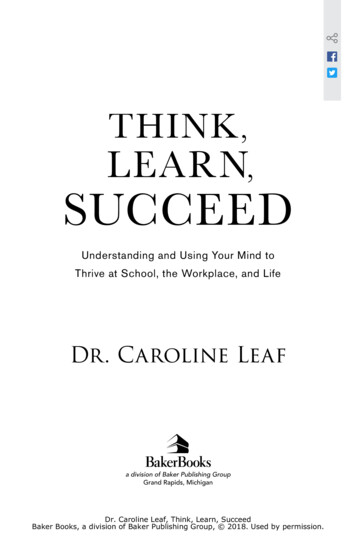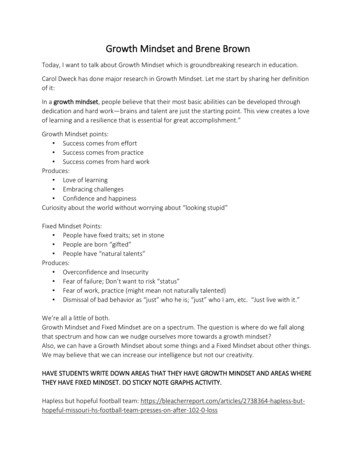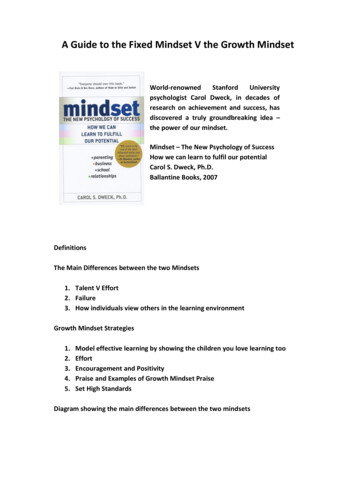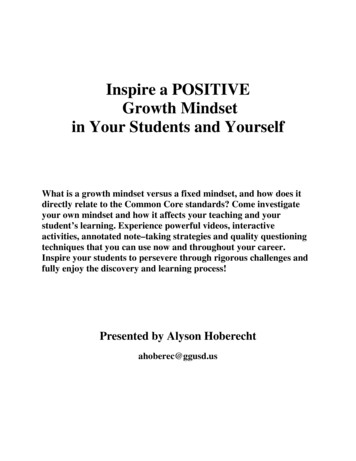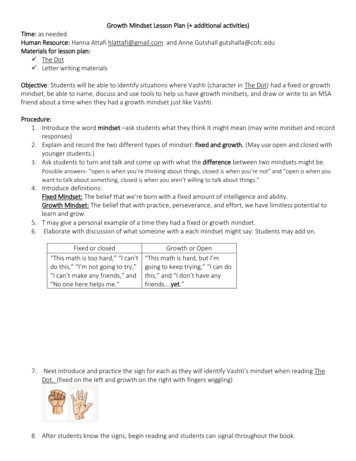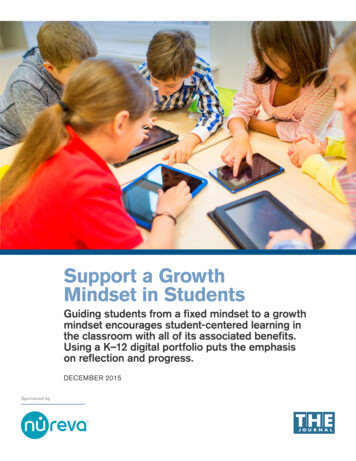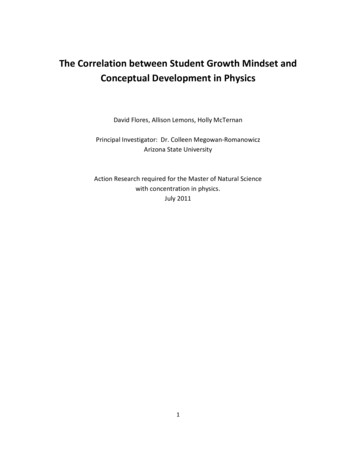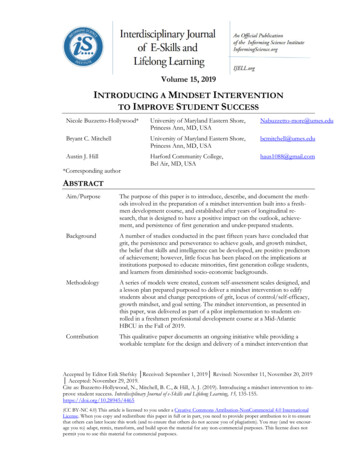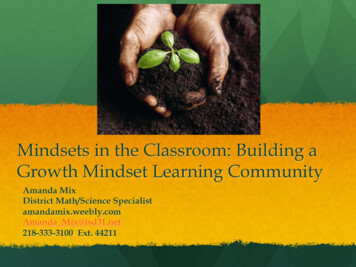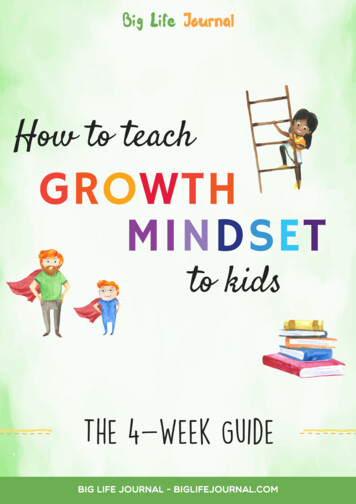
Transcription
Big Life JournalHow to teachGROWTHMINDSETto kidsThe 4-Week GuideBIG LIFE JOURNAL - BIGLIFEJOURNAL.COM
THE 4-WEEK GUIDE TOTEACHING A GROWTH MINDSETIntroductionDeveloping the right mindset early on is crucial for a full, big life. When kids learn puttingforth effort and using the right strategies can make them smarter, they try harder andachieve more. When they know their brains are capable of growing, amazing things canhappen!So how do we TEACH this simple and incredible concept to children? To start, we wouldlike to make sure you understand the basics.WHAT IS GROWTH MINDSET?We all have beliefs about our own abilities and potential. These beliefs are part of ourmindset which is so powerful it can fuel our behavior and predict our success. Mindsetshapes our everyday lives, helping us interpret our experiences and future possibilities.In her research at Stanford University, Dr. Carol Dweck identified two different types ofmindsets. Growth mindset occurs when we believe our intelligence and abilities can beimproved upon with effort and the right strategies.A willingness to confront challenges, a passion for learning and viewing failure as aspringboard for growth are all characteristics associated with a growth mindset. Notsurprisingly, this type of mindset is strongly linked to greater happiness and achievement inlife.In contrast, those with a fixed mindset believe their intelligence and abilities cannot bealtered in a meaningful way. As a result, mistakes are often seen as failures rather thanopportunities to grow and learn. When stuck in a fixed mindset, we may fear newexperiences, avoid risks, and feel the need to repeatedly prove ourselves over and over.ABOUT THE 4-WEEK GUIDETeaching a growth mindset to children is not an easy task but it could become one of thegreatest contributions you make towards their success and happiness.In this 4-week guide, you will find the KEY elements for establishing a growth mindset athome or in your classroom. Each week offers a variety of suggested activities andresources, as well as suggested scripts to facilitate easy and fun discussions with yourchild or students.BIG LIFE JOURNAL - BIGLIFEJOURNAL.COM2
THE 4-WEEK GUIDE TOTEACHING A GROWTH MINDSETWeek One: Introduce ItThis week, children will learn about the concept of mindset and how the two types, growthand fixed, differ. We will also discuss the BRAIN and how it can grow and strengthen inresponse to challenges.As you introduce these new ideas, keeping the tone fun and light will go a long way towardsengaging kids.Step 1: Building The FoundationHave a family or classroom discussion about the following questions:1. What does it mean to GROW? What kinds of things grow? Answers will vary.Growth means to develop, change, mature, evolve. Living things grow - plants,animals, and people. Even our brains can grow!2. When you think of the brain or minds, what do you think MINDSET means?Mindsetis the way our brain thinks about things we do. Our mindset helps us look atproblems, as well as mistakes, in a positive way!3. Let’s put those words together: growth and mindset. When we combine them, itmeans something really important. What could growth mindset mean? A growthmindset is believing in the power of yourself and your brain! We know our intellectand abilities develop when we try hard things, use the right strategies, and don’t giveup. So a growth mindset is when we know, with practice, we will get better atsomething.4. If fixed is the opposite of growth, what does it mean to have a FIXED mindset? Afixed mindset means you think you can’t get better at things, even if you practice.Wanting to quit, give up, or deciding we’re just not good at something are all clues wehave a fixed mindset.You can use the Mindset Poster to help your childvisualize the difference between the two mindsets.BIG LIFE JOURNAL - BIGLIFEJOURNAL.COM3
THE 4-WEEK GUIDE TOTEACHING A GROWTH MINDSETWeek One: Introduce ItUse the suggested script below to discuss mindset."Everyone in the world has a way of seeing things. We call this a mindset. You have amindset, your friends have a mindset and your teacher has a mindset. Let's start talkingabout the way we see things using our mindset.We can choose to look at the world in a way that makes us feel strong and happy, or in away that makes us feel frustrated and we can’t improve.People with a growth mindset know they can get better by working hard. They keep tryingeven when things are tough and they say things such as, ‘I can’t do this.yet’ or ‘Mistakeshelp me learn.’People with a fixed mindset feel differently, as if they are stuck with the way things are. Afixed mindset can happen to anyone at some time or another but it's important we choose tohave a growth mindset, keep trying and stick with challenges."Step 2: ReflectionShare a personal story about when you were stuck and used hard work or help from othersto overcome a challenge.Ask your child or class to share similar examples from their lives. In theclassroom, this could be done with everyone together or in smaller groups.Use the Growth Mindset Maze printable (in the Growth MindsetPrintables Kit) as a fun activity for kids to practice their knowledgeabout the mindsets.Step 3: Growth Mindset and The BrainDiscuss the brain and its remarkable ability to change and grow. Use our suggested scriptbelow.“Now that we know what growth mindset is, let’s talk a little more about our brain and theamazing things it can do! Did you know you can grow your brain when you try new thingsand don’t give up when something is tough?BIG LIFE JOURNAL - BIGLIFEJOURNAL.COM4
THE 4-WEEK GUIDE TOTEACHING A GROWTH MINDSETWeek One: Introduce ItLearning something new is hardest the first time, but your brain behaves like a muscleand gets stronger every time things are repeated. Let’s watch a video [see suggestionsbelow] to help us understand this even better.”Use the "I Can Grow My Brain" poster for this step. It's a great way for your kids orstudents to learn more about how their brain works and have fun along the way.Suggested Resources for Week One1. Mindset Poster (PDF) is a visual representation of growthand fixed mindsets and helps children understand thedifference between the two.2. "I Can Grow My Brain" Poster (in the Growth MindsetPrintables Kit) is a fun activity where kids learn about thepower of their brain.3. Growth Mindset Maze (in the Growth Mindset PrintablesKit) is a fun activity where kids decide whether a statementbelongs to a fixed or a growth mindset.4. Parent's Guide to a Growth Mindset (in the GrowthMindset Printables Kit) provides specific examples of whatto say/ask to help your children develop a growth mindset.5. Big Life Journal is a growth mindset journal broken downinto 26 weeks. Use Week One to discuss how having agrowth mindset can help us positively impact other peopleand the world around us.READ1. Fantastic Elastic Brain by JoAnn Deak (ages 4-8)2. The Ultimate Guide to Praising Your Kids (article foradults)3. The Brain is Like a Muscle (article for adults and older kids)WATCH1. Growth Mindset Video (2.5 minutes)2. Learning and the Brain (3 minutes)BIG LIFE JOURNAL - BIGLIFEJOURNAL.COM5
THE 4-WEEK GUIDE TOTEACHING A GROWTH MINDSETWeek Two: Notice ItThis week, we begin to identify growth and fixed mindsets in ourselves and others.Everywhere we look, we can find examples of others either quitting or working through theirproblems.Step 1: Reflecting on DefinitionsGo back to the definitions of growth and fixed mindset from Week 1. Did anyone notice atime he/she was using either mindset? Discuss how we can change from fixed to growthmindset with simple words and phrases that, we can begin practicing TODAY.Use the suggested script below:“Last week we talked a lot about growth mindset and how our brains get stronger when westick with hard things. Have you noticed a time you had a growth mindset in the last fewdays? Did you feel your brain growing? What about a time you felt stuck?”Step 2: Growth Mindset StatementsAsk your child/class to think of some FIXED mindset phrases commonly used inhome/school (“I give up”, “I can’t do this”) and write them down.Next, create a list of alternate phrases that reflect growth mindset (“I’m not good at this yet”).Above the fixed mindset column, write “Instead of” and on the Growth mindset column, “ICan Say ”Use the suggested script below:“Let's think of things we say when we're stuck in a fixed mindset and write them down. Wecan then come up with other words to change the fixed mindset into a growth mindset. I'msure we can come up with lots of ideas!”Alternatively, you can use the Growth MindsetStatements printable from the Growth Mindset PrintablesKit.BIG LIFE JOURNAL - BIGLIFEJOURNAL.COM6
THE 4-WEEK GUIDE TOTEACHING A GROWTH MINDSETWeek Two: Notice ItStep 3: Using VisualsDisplay visuals around your home/classroom as constant reminders of new vocabulary andideas. Have the child/class locate their favorite spots to hang posters and refer to themfrequently throughout the day.Then, when you hear a child making a fixed mindset statement, you can simply point to apositive quote and have him/her repeat it.You can use the printable posters: Growth Mindset Poster,Success Iceberg Poster, and You Can Learn Anything Poster.Step 4: Daily RoutinesConsider daily routines and how growth mindset can be easily embedded. Set aside at leastseveral minutes each day to discuss and reflect on them.As a family: Consider how growth mindset LOOKS, FEELS, and SOUNDS at home. Discussspecific ways we can help each other when we’re “stuck” and need help shifting ourperspective from a fixed to a growth mindset.In school: Consider how growth mindset LOOKS, FEELS, and SOUNDS in class. MakeGrowth Mindset Monitor one of your classroom jobs. End the school day with time for studentsto share their mindset experience.Use the printables "We Are a Growth Mindset Class/Family" from the Growth Mindset Printables Kit.Step 5: Book and Movie CharactersIdentify growth and fixed mindsets in favorite book and movie characters. Pay attention to howthe characters FEEL depending on their mindset and discuss ways persistence, love oflearning, and resilience are portrayed.Point out when a character does the hard work of shifting from a fixed to a growth mindset too!BIG LIFE JOURNAL - BIGLIFEJOURNAL.COM7
THE 4-WEEK GUIDE TOTEACHING A GROWTH MINDSETWeek Two: Notice ItUse the suggested script below:“In so many of your favorite books and movies, the characters are learning to have growthmindsets too. Let’s pick one now and try to find all the ways we see it happening!”Use our Book Review Printable from the Growth Mindset Printables Kit, as a fun activity forkids to practice noticing growth mindset characters in books.Suggested Resources for Week Two1. 5-Day Growth Mindset Challenge (in the Challenges Kit) willhelp your child practice growth mindset concept andvocabulary.2. Posters: Growth Mindset Poster, Success Iceberg Poster,and You Can Learn Anything Poster can be hung in abedroom or a classroom.3. Growth Mindset Statements (in the Growth MindsetPrintables Kit)4. We are a Growth Mindset Family/Class (in the GrowthMindset Printables Kit)5. Book Review Printable (in the Growth Mindset Printables Kit)6. Big Life Journal: In Week Two, continue discussing howhaving a growth mindset can help us positively impact otherpeople and the world around us.READ1. Top 85 Growth Mindset Books for Children and Adults isa list of our favorite and most popular books for you and yourkids!2. 25 Growth Mindset Statements and AffirmationsWATCHTop 50 Growth Mindset Movies for Children is a list of movieswith characters who demonstrate a growth mindset and qualitiessuch as grit, perseverance, courage, and determination.BIG LIFE JOURNAL - BIGLIFEJOURNAL.COM8
THE 4-WEEK GUIDE TOTEACHING A GROWTH MINDSETWeek Three: Model ItYour ability to MODEL a growth mindset can make the difference between a childunderstanding the concept and actually living it.Let them see your growth mindset in action.Step 1: Being OpenBe honest when something is tricky for you. Tell kids when you’re discouraged, share yourfixed mindset thoughts and brainstorm solutions aloud. Show them we’re ALL learning thisgrowth mindset thing together!Step 2: Mindset and FeelingsExplore how positive feelings such as pride and happiness come from persisting throughchallenges. When stuck in a fixed mindset, share how you felt sad, anxious, or even hopeless.Negative feelings may serve as clues that you need to shift your thinking.Step 3: Learning Something NewSet a goal for yourself to learn something new and share your learning process. How did youfeel at the start? How did you set that goal for yourself and go about achieving it? Reviewways children can set and meet their own goals!Use the Goal-Setting Printables from the Self-Esteem & Confidence Kit as a fun activity foryou and kids to practice setting new goals.BIG LIFE JOURNAL - BIGLIFEJOURNAL.COM9
THE 4-WEEK GUIDE TOTEACHING A GROWTH MINDSETWeek Three: Model ItStep 4: The Power of YETWith one simple word, any fixed mindset phrase can be transformed into a statement ofhope. “I can’t do this.yet.” It’s all about the FUTURE, and not giving up until we get there.Make a “YET” bulletin board or designate a wall at home for all the things you can’tdo.yet!You can also use My Power of YET printable fromthe Growth Mindset Printables Kit as a fun activityfor you and kids.Use the suggested script below:“Even though I know about growth mindset, I still haveto work at it. Especially when something is hard for me.I can tell I’m in a fixed mindset when I have thoughtsabout quitting and start to feel sad. When I feel that way,I know I need to change my thinking to a different mindset.One way that works is just using the word ‘yet.’ We can add it onto the end of almost anysentence to change our thinking. For example, when I get frustrated by a challenge andthink ‘I’ll never get it,’ I just say, “I don’t get it.yet.” Or if I think I can’t do something, I’llsay, “I can’t do it.yet.”Can you think of a sentence that ends with ‘yet’ which would make you feel better?‘YET’ is kind of like a magic word. It shows we can keep trying and not give up onourselves or our dreams.”BIG LIFE JOURNAL - BIGLIFEJOURNAL.COM10
THE 4-WEEK GUIDE TOTEACHING A GROWTH MINDSETWeek Three: Model ItSuggested Resources for Week Three1. Goal-Setting printables (in the Self-Esteem & ConfidenceKit) will make goal setting more fun and effective.2. My Power of YET printable (in the Growth MindsetPrintables Kit)3. Famous Failures Kit is a set of stories highlighting famouspeople from around the world who have failed and struggledon their way to success.4. Big Life Journal: In Week Three, discuss how having agrowth mindset can help achieve their biggest dreams.READ1. Not Yet by Lisa Cox (ages 4-8)2. Flight School by Lita Judge (ages 4-8)WATCH1. Janelle Monae “The Power of Yet” (Sesame Street, 2015)(2.5 minutes)2. C.J. Luckey - The Power of Yet by Andre Kahmeyer(4 minutes)BIG LIFE JOURNAL - BIGLIFEJOURNAL.COM11
THE 4-WEEK GUIDE TOTEACHING A GROWTH MINDSETWeek Four: Practice ItGrowth mindset is all about effort, so what better way to teach it than through practice,practice, practice?Step 1: PraisePraise for perseverance in problem-solving rather than being “smart” or talented. Connectpositive results with effort rather than innate ability, and children will be more willing to takerisks and value hard work. When you notice hard work or positive self-talk, make sure theyknow it!The Growth Mindset Praise printable (part of the Growth Mindset Printables Kit) providesspecific examples for you.Step 2: Positive ReinforcementThis is especially helpful for younger children. For example, create a simple game where kidsreceive a sticker or a cotton ball for practicing a growth mindset. For every 10 cotton balls orstickers, the child gets to choose a game everyone plays.Step 3: Productive StruggleIn the safe environment of your home or class, give children time to consider their challengesand ask you questions about them. Grappling with a problem builds resilience, so give kidstime for reflection before jumping in to help or “save” them.Step 4: Reframing MistakesGet excited when opportunities for growth occur! In a challenging moment, say things like,“This seems like an opportunity to grow our brains!” Create anenvironment where setbacks are expected and even celebrated.Have kids read our fun Mistakes Poem (theGrowth Mindset Printables Kit) to get them excitedabout their mistakes and failures.BIG LIFE JOURNAL - BIGLIFEJOURNAL.COM12
THE 4-WEEK GUIDE TOTEACHING A GROWTH MINDSETWeek Four: Practice ItStep 5: Hitting PauseExercising the brain can be hard for kids. When your child (or you) becomes frustrated, it’sokay to take a break. “It’s time to give our brains a little rest. We’ll come back to thistomorrow!”Being watchful of your own fixed mindset “triggers” can help with this process.Suggested Resources for Week Four1. Growth Mindset Praise printable (in the Growth MindsetPrintables Kit) provides specific examples of the praise.2. Mistakes Poem printable (in the Growth Mindset PrintablesKit)3. Big Life Journal: In Week Four, continue discussing howhaving a growth mindset can help anyone achieve their biggestdreams.READ1. Mistakes That Worked by Charlotte Foltz Jones(ages 8-12)2. The Most Magnificent Thing by Ashley Spires(ages 3-7)3. How to Teach Problem Solving Skills to Kids(article for adults)PROJECTWriting affirmations on pencils is a fun way to reinforce growthmindset statements and encourage your kids.BIG LIFE JOURNAL - BIGLIFEJOURNAL.COM13
THE 4-WEEK GUIDE TOTEACHING A GROWTH MINDSETRecapIn a few short weeks, children can establish a foundation in growth mindset and a newway of viewing challenges. We encourage you to go beyond the four weeks. Make themindset the cornerstone of your child’s learning!Simple strategies such as praising effort, reframing mistakes as opportunities, andembracing “YET” are powerful methods for shifting their thinking, and ours! When wemodel a growth mindset by facing challenges and showing OUR persistence, kids knowthey have an ally on this journey.Armed with a positive mindset and the knowledge that growth and change are alwayspossible, kids will be ready to tackle their big, wonderful life ahead!For the complete collection of Big Life Journal products, go HERE.Big Life Journal offers discounts on bulk orders, including special school discounts.BIG LIFE JOURNAL - BIGLIFEJOURNAL.COM
In her research at Stanford University, Dr. Carol Dweck identified two different types of mindsets. Grow th mindset occurs when we believe our intelligence and abilities can be improved upon with effort and the right strategies. A willingness to confront ch
